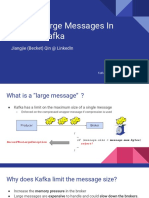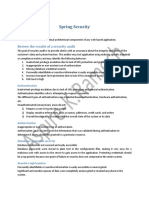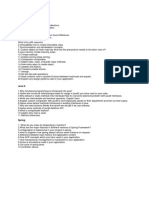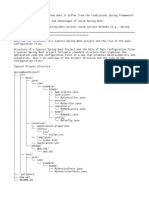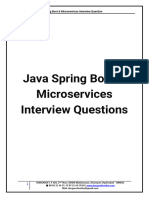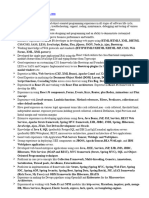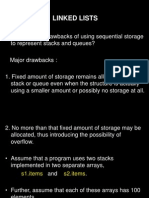How Hashmap Works in Java
Uploaded by
Sonal MhatreHow Hashmap Works in Java
Uploaded by
Sonal MhatreHow Hashmap works in Java
HashMap works on the principle of Hashing . To understand Hashing , we
should understand the three terms first i.e Hash Function , Hash Value and
Bucket .
What is Hash Function , Hash Value and Bucket ?
hashCode() function which returns an integer value is the Hash function.
The important point to note that , this method is present in Object class (
Mother of all class ) .
This is the code for the hash function(also known as hashCode method) in
Object Class :
public native int hashCode();
The most important point to note from the above line : hashCode method
return int value .
So the Hash value is the int value returned by the hash function .
So summarize the terms in the diagram below :
What is bucket ?
A bucket is used to store key value pairs . A bucket can have multiple key-
value pairs . In hash map, bucket used simple linked list to store objects .
After understanding the terms we are ready to move next step , How hash map
works in java or How get() works internally in java .
Code inside Java Api (HashMap class internal implementation) for
HashMap get(Obejct key) method
1. Public V get(Object key)
{
2. if (key ==null)
3. //Some code
4. int hash = hash(key.hashCode());
5. // if key found in hash table then return value
6. // else return null
}
Hash map works on the principle of hashing
HashMap get(Key k) method calls hashCode method on the key object and
applies returned hashValue to its own static hash function to find a bucket
location(backing array) where keys and values are stored in form of a nested
class called Entry (Map.Entry) . So you have concluded that from the
previous line that Both key and value is stored in the bucket as a form of
Entry object . So thinking that Only value is stored in the bucket is not
correct and will not give a good impression on the interviewer .
* Whenever we call get( Key k ) method on the HashMap object . First it
checks that whether key is null or not . Note that there can only be one null
key in HashMap .
If key is null , then Null keys always map to hash 0, thus index 0.
If key is not null then , it will call hashfunction on the key object , see line 4 in
above method i.e. key.hashCode() ,so after key.hashCode() returns
hashValue , line 4 looks like
4. int hash = hash(hashValue)
, and now ,it applies returned hashValue into its own hashing function .
We might wonder why we are calculating the hashvalue again using
hash(hashValue). Answer is ,It defends against poor quality hash functions.
Now step 4 final hashvalue is used to find the bucket location at which the
Entry object is stored . Entry object stores in the bucket like this
(hash,key,value,bucketindex) .
Interviewer: What if when two different keys have the same hashcode ?
Solution, equals() method comes to rescue.Here candidate gets puzzled.
Since bucket is one and we have two objects with the same hashcode
.Candidate usually forgets that bucket is a simple linked list.
The bucket is the linked list effectively . Its not a LinkedList as in a
java.util.LinkedList - It's a separate (simpler) implementation just for the
map .
So we traverse through linked list , comparing keys in each entries using
keys.equals() until it return true. Then the corresponding entry object Value is
returned .
One of our readers Jammy asked a very good question
When the functions 'equals' traverses through the linked list does it traverses
from start to end one by one...in other words brute method. Or the linked list is
sorted based on key and then it traverses?
Answer is when an element is added/retrieved, same procedure follows:
a. Using key.hashCode() [ see above step 4],determine initial hashvalue for
the key
b. Pass intial hashvalue as hashValue in hash(hashValue) function, to
calculate the final hashvalue.
c. Final hash value is then passed as a first parameter in the indexFor(int ,int
)method .
The second parameter is length which is a constant in HashMap Java Api ,
represented by DEFAULT_INITIAL_CAPACITY
The default value of DEFAULT_INITIAL_CAPACITY is 16 in HashMap
Java Api .
indexFor(int,int) method returns the first entry in the appropriate bucket. The
linked list in the bucket is then iterated over - (the end is found and the
element is added or the key is matched and the value is returned )
Explanation about indexFor(int,int) is below :
/**
* Returns index for hash code h.
*/
static int indexFor(int h, int length) {
return h & (length-1);
}
The above function indexFor() works because Java HashMaps always have a
capacity, i.e. number of buckets, as a power of 2.
Let's work with a capacity of 256,which is 0x100, but it could work with any
power of 2. Subtracting 1
from a power of 2 yields the exact bit mask needed to bitwise-and with the
hash to get the proper bucket index, of range 0 to length - 1.
256 - 1 = 255
0x100 - 0x1 = 0xFF
E.g. a hash of 257 (0x101) gets bitwise-anded with 0xFF to yield a bucket
number of 1.
Interviewer: What if when two keys are same and have the same hashcode ?
If key needs to be inserted and already inserted hashkey's hashcodes are
same, and keys are also same(via reference or using equals() method) then
override the previous key value pair with the current key value pair.
The other important point to note is that in Map ,Any class(String etc.) can
serve as a key if and only if it overrides the equals() and hashCode()
method .
Interviewer: How will you measure the performance of HashMap?
According to Oracle Java docs,
An instance of HashMap has two parameters that affect its performance: initial
capacity and load factor.
The capacity is the number of buckets in the hash table( HashMap class is
roughly equivalent to Hashtable, except that it is unsynchronized and permits
nulls.), and the initial capacity is simply the capacity at the time the hash table
is created.
The load factor is a measure of how full the hash table is allowed to get
before its capacity is automatically increased. When the number of entries in
the hash table exceeds the product of the load factor and the current capacity,
the hash table is rehashed (that is, internal data structures are rebuilt) so that
the hash table has approximately twice the number of buckets.
In HashMap class, the default value of load factor is (.75) .
Interviewer : What is the time complexity of Hashmap get() and put() method ?
The hashmap implementation provides constant time performance for (get
and put) basic operations
i.e the complexity of get() and put() is O(1) , assuming the hash function
disperses the elements properly among the buckets.
Interviewer : What is the difference between HashMap and
ConcurrentHashMap ?
It is also one of the popular interview question on HashMap , you can find the
answer here
HashMap vs ConcurrentHashMap
You might also like
- Java-Frequently Asked Interview QuestionsNo ratings yetJava-Frequently Asked Interview Questions2 pages
- Public Class: Singleton, Prototype, Request, Session and Global SessionNo ratings yetPublic Class: Singleton, Prototype, Request, Session and Global Session6 pages
- Spring MVC Interview Questions With Answers - HowToDoInJava0% (1)Spring MVC Interview Questions With Answers - HowToDoInJava29 pages
- Java Basic Interview Questions: 1. Why Is Java A Platform Independent Language?No ratings yetJava Basic Interview Questions: 1. Why Is Java A Platform Independent Language?32 pages
- Spring Annotations Reference: Spring MVC Spring Boot Spring Data JPA This BlogNo ratings yetSpring Annotations Reference: Spring MVC Spring Boot Spring Data JPA This Blog6 pages
- Sun Certified Enterprise Architect SCEA Mock Exams100% (1)Sun Certified Enterprise Architect SCEA Mock Exams132 pages
- Java Multithreading Concurrency Interview Questions and Answers - JournalDevNo ratings yetJava Multithreading Concurrency Interview Questions and Answers - JournalDev25 pages
- Solid Principles in Spring Boot ApplicationsNo ratings yetSolid Principles in Spring Boot Applications8 pages
- Microservices Architecture Using Spring Boot and Netflix InfrastructureNo ratings yetMicroservices Architecture Using Spring Boot and Netflix Infrastructure6 pages
- Java Spring Boot Microservices Training Content - Manish SinghNo ratings yetJava Spring Boot Microservices Training Content - Manish Singh1 page
- New Features in JDK 8: Ivan St. Ivanov Dmitry Alexandrov Martin ToshevNo ratings yetNew Features in JDK 8: Ivan St. Ivanov Dmitry Alexandrov Martin Toshev58 pages
- JAVA Spring Boot and Microservices CurriculamNo ratings yetJAVA Spring Boot and Microservices Curriculam3 pages
- Top Spring Framework Interview Questions - BaeldungNo ratings yetTop Spring Framework Interview Questions - Baeldung10 pages
- Java Spring Boot Microservices Example - 27122023No ratings yetJava Spring Boot Microservices Example - 271220236 pages
- Spring Boot Actuator Spring Boot 2 Recipes A Problem-Solution ApproachNo ratings yetSpring Boot Actuator Spring Boot 2 Recipes A Problem-Solution Approach15 pages
- Introduction to Mastering Modern Web Technologies with React.js and Ant DesignFrom EverandIntroduction to Mastering Modern Web Technologies with React.js and Ant DesignNo ratings yet
- Design and Analysis of Algorithms Lab Manual: Computer Science & Engineering Department NMAMIT, NitteNo ratings yetDesign and Analysis of Algorithms Lab Manual: Computer Science & Engineering Department NMAMIT, Nitte33 pages
- Information Theory and Coding: 4 Electrical Engineering by DR Wassan SaadNo ratings yetInformation Theory and Coding: 4 Electrical Engineering by DR Wassan Saad26 pages
- 9691-CIE-Answers (3.4) - Data Representation and StructuresNo ratings yet9691-CIE-Answers (3.4) - Data Representation and Structures17 pages
- Billion-Scale Similarity Search With GPUsNo ratings yetBillion-Scale Similarity Search With GPUs12 pages
- Learning by Asking Questions: Decision Trees: Piyush Rai Machine Learning (CS771A)No ratings yetLearning by Asking Questions: Decision Trees: Piyush Rai Machine Learning (CS771A)91 pages
- Module 3. Solving Problems by Searching - 20230824 - 200318 - 0000No ratings yetModule 3. Solving Problems by Searching - 20230824 - 200318 - 000015 pages
- SAP HANA PAL - K-Means Algorithm or How To Do Cust... - SAP Community-CNo ratings yetSAP HANA PAL - K-Means Algorithm or How To Do Cust... - SAP Community-C6 pages
- CS 321-Analysis of Algorithms: Instructor: Asim RehanNo ratings yetCS 321-Analysis of Algorithms: Instructor: Asim Rehan30 pages
- Op#miza#on Problems,: John Gu7ag MIT Department of Electrical Engineering and Computer ScienceNo ratings yetOp#miza#on Problems,: John Gu7ag MIT Department of Electrical Engineering and Computer Science33 pages
- Hierarchical Document Clustering Using Frequent Itemsets: Benjamin FungNo ratings yetHierarchical Document Clustering Using Frequent Itemsets: Benjamin Fung37 pages













